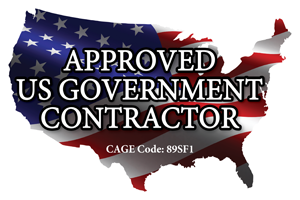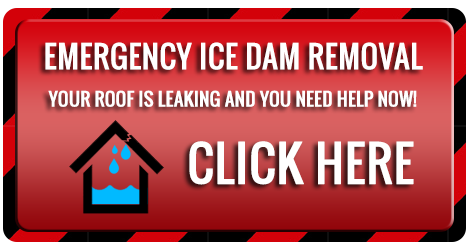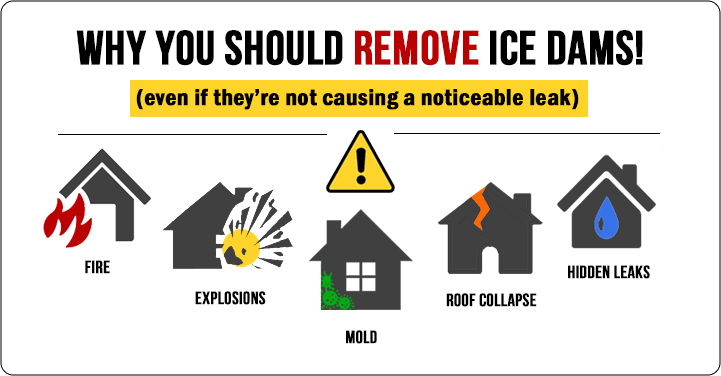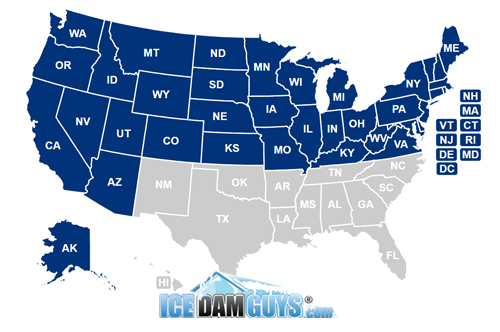How to Protect Your Home from the Snow and Ice of Winter Storm Jonas
Winter Storm Jonas is barreling up and down the East Coast, and some of the effect reach as far south as Alabama. Many residents are in the path of Jonas aren’t used to snowstorms like it, which is forecast to bring between 18 and 24 inches of wet, heavy snow to many areas this weekend.
In conditions like these, homeowners face two big concerns. The first is the threat of ice dams, which can cause massive leaks inside of the home. The second danger is the possibility of a roof collapse.
To alleviate these two concerns, residents within the affected areas of heavy snow accumulation are urged to get the snow off of their roofs as soon as it is safe and feasible to do so.
Jonas is bringing the optimal conditions for big trouble.
The 7-day forecast for the DC area (which is expected to be hit the hardest) indicates the optimum conditions for both kinds of damage. Beginning on Sunday, highs are expected to range into the mid-thirties to mid-forties, but lows are expected to plunge as low as 13° some nights.
That means that the snow atop area homes and businesses will be repeatedly melting and re-freezing throughout the week. Ice dams will almost certainly form, especially since most of the homes in Jonas’ path do not have adequate insulation in their attics, such as homes within colder regions of the U.S. Lack of sufficient insulation equates to a warm attic space. This means that a homeowner’s roof deck is likely to get warmed from the underside, by the warm attic space below it. This accelerates the melting of snow, and intensifies the freeze/thaw cycles, thus causing the formation of ice dams.
An ice dam is simply a small to large wall of ice that typically forms along overhangs and within the roof valleys. Melting snow gets trapped behind this wall of ice, where it pools up and eventually works its way up the roof (beyond the exterior walls), and ultimately beneath the shingles. When this happens, the roof begins to leak inside your home.
Ice on the roof contributes to the danger of a collapse. Institute for Business and Home Safety (IBHS) indicates one inch of ice equals approximately one foot of snow. A foot of snow can be a serious hazard on its own, weighing in at 12 lbs. to 23.76 lbs. per square foot of roof, depending upon how wet it is. And, that’s not taking into account any ice buildup whatsoever, which can weight roughly 12 times as much as snow.
Homeowners with a 2,237 square foot roof (which is about average for a DC roof) could see at least 40,226 lbs. of weight overhead, even before one adds ice into the equation.
That is the minimum equivalent of parking 13 Toyota Priuses on top of a home.
High winds exacerbate conditions still further. Snow will tend to collect wherever the roof meets an exterior wall, forming drifts that double, triple, and even quadrupole this weight in a single spot.
How much snow is too much snow? Signs a roof collapse is imminent:
While this storm is raging homeowners need to be especially vigilant. Fortunately, roof collapses rarely happen without warning. Our homes often times provide us with many warning signs that a collapse could soon occur. Get out of the home and call a snow removal professional if:
- Sections of the roof are sagging.
- You suddenly can’t open doors or windows in your home.
- You notice deformities in your roofing structure.
- You start seeing cracks in the exterior masonry.
- You note new cracks in the ceilings or interior walls.
- The ceiling starts to sag.
- Doors start popping open on their own.
- You notice bent or bowed pipes in your utility room.
- And the big one…if you start hearing creaking, popping, or cracking sounds from your roof or walls, get out. These sounds start happening only when the roof is very close to collapsing. Do not remain in the home. Get somewhere safe and call a rooftop snow removal professional immediately.
Warning signs of ice dams—watch these to prevent costly leak damage in your home.
Ice dams don’t appear in a vacuum either. You can almost always tell when an ice dam is forming, and you can definitely tell when an ice dam is getting dangerous. The warning signs include:
- Icicles on your roof. You want to look at the size and placement of the icicles. Small icicles along the edge of your roof, for the most part, aren’t dangerous, but instead are early warning signs that an ice dam is developing. Larger icicles along the edge of your roof, accompanied by ice buildup on your overhangs or even worse yet, ice buildup under the overhangs indicates that a large ice dam is forming and should be removed ASAP.
- If you have ice on your siding, you’ll typically see a roof leak into your home within 10-12 hours, depending on the ambient hi and low temperatures. This is a sign that water has already worked its way under the shingles and is creeping back towards the exterior walls, and soon inside your walls, and then your living space.
- Look for gutters that are stuffed with ice—this, again, is a sign that the ice is building up to dangerous levels.
- Look for a wall of thick ice on the overhang. Anything more than a few inches in thickness should be removed ASAP to avoid potential leaks into the home.
Obviously, if you have a roof leak you definitely have a critical ice dam emergency and you need to secure the help of an ice dam removal professional right away. The sooner you act, the better off you’ll be…ice dam professionals often end up with more work than they know what to do with when these sorts of weather conditions arrive, and as a result may not be able to get to you before you start to suffer from extensive damage.
When in doubt, get the snow off your roof…it may save you $10,000 or more.
Homeowners have two options when it comes to getting snow off of their roof: using a roof rake specially designed for this purpose, or calling a snow removal service.
Raking snow off the roof will be difficult thanks to the sheer volume of expected snow. A homeowner committed to raking may have to venture outside several times during the storm in order to effectively get as much snow off the roof as possible (i.e., trying to remove it all at once can be extremely difficult). Choose a time when visibility is good and keep your feet safely planted on the ground while carefully pulling small sections of snow at a time down to the ground.
If it’s not safe to get outside or if it’s difficult to reach large portions of the roof it may be better to call a professional snow removal service or ice dam removal service. Most ice dam removal companies also provide rooftop snow removal services.
Homeowners who see icicles should be especially vigilant, opting to call for help as soon as possible. Icicles may be pretty, but as stated earlier, they’re also an early warning sign that ice dams have begun to form.
Rooftop snow removal services (via a roof snow removal company) typically cost between $375 and $575 per man-hour from a properly insured roof snow removal company, a mere pittance when compared to the costs of repairing the potential damage caused to your home as a result of roof leaks and/or roof collapses. But nonetheless, expensive.
Roof collapses can also be fatal to people inside the building, another reason to commit to potentially making the investment into removing the snow from atop your roof. Those who want to save a little cash might opt for a combination of raking as much of the roof themselves as possible, and hiring professional help to remove what they cannot do themselves.
There’s certainly a lot to be said for the emotional payoff of remaining warm, dry, and safe at home while less prudent residents become tomorrow’s news story.
Important Note: If you’re hiring an “ice dam removal” company for roof snow removal, you can expect to pay their regular “ice dam removal rates.” Why? Because that steamer in the back of their truck could be working somewhere else for ice dam removal rates.






















No comments yet. You should be kind and add one!
Leave a Comment